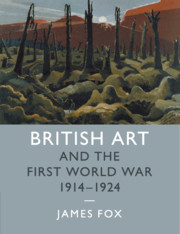Book contents
- Frontmatter
- Contents
- List of plates
- List of figures
- Acknowledgements
- Introduction
- 1 The outbreak of war and the business of art
- 2 Perceptions of art
- 3 The arts mobilize
- 4 War pictures: truth, fiction, function
- 5 Peace pictures: escapism, consolation, catharsis
- 6 Art and society after the war
- Conclusion
- Notes
- Bibliography
- Index
- Index
5 - Peace pictures: escapism, consolation, catharsis
Published online by Cambridge University Press: 05 August 2015
- Frontmatter
- Contents
- List of plates
- List of figures
- Acknowledgements
- Introduction
- 1 The outbreak of war and the business of art
- 2 Perceptions of art
- 3 The arts mobilize
- 4 War pictures: truth, fiction, function
- 5 Peace pictures: escapism, consolation, catharsis
- 6 Art and society after the war
- Conclusion
- Notes
- Bibliography
- Index
- Index
Summary
The First World War created a set of unusual social demands that could be satisfied only by images. The public's desire to see the war, the press's determination to profit from the war and the government's need to manage the war made images of the front line an extremely useful currency on the home front. These demands had many cultural consequences, of which the proliferation and official endorsement of war art was one. This was only part of the story, for the simple reason that war art was not the only kind of art to be produced between 1914 and 1918. The conflict gave rise to another very different set of social needs, which in turn produced another set of artworks. These needs emerged later than those that provoked the nation's much-discussed war pictures, but they grew with every year of the conflict and by its end they were considerably more influential. The images that resulted from them could not have been more different from their bellicose counterparts, for their function was not to help Britons confront the hardships of war but rather to escape and overcome them.
Scholars have traditionally neglected the consolatory strands of wartime culture because they do not fit the narratives of despair, disillusionment and dissent that have long governed interpretations of the field. In recent years, however, these cultural trends have finally started to receive the attention they deserve. The process began in 1995 with the publication of Jay Winter's cultural history of the war, Sites of Memory, Sites of Mourning. In that text Winter challenged the dominant view that artists’ widespread determination to tell the ‘bitter truth’ about the front line led to an ascendancy of modern modes of expression. He claimed that though the conflict engendered a great deal of rebarbative war art, it also reinvigorated more traditional and reassuring cultural modes that helped grieving communities ‘live with their losses’. His persuasive argument has since rippled through other disciplines, as literary critics, archaeologists and military historians have begun to explore the ways that all kinds of cultural output – from diaries and mementoes to cinemas and singing groups – helped counteract rather than chronicle the disasters of war.
- Type
- Chapter
- Information
- British Art and the First World War, 1914–1924 , pp. 109 - 132Publisher: Cambridge University PressPrint publication year: 2015



